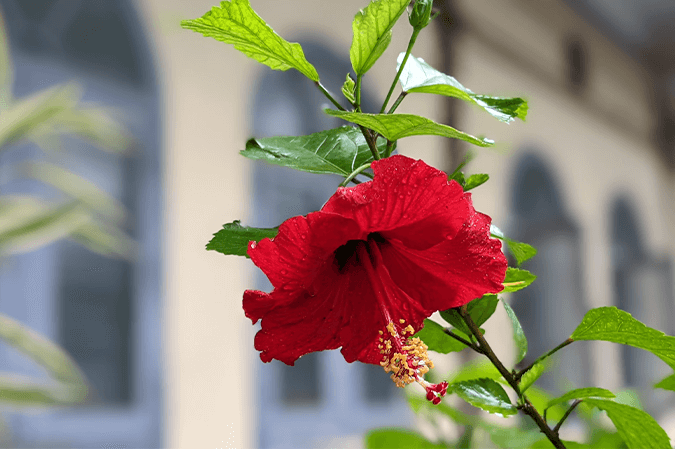Description
Hibiscus is a genus of flowering plants in the mallow family, Malvaceae. There are over 300 species within the genus, found in warm temperate, subtropical, and tropical regions throughout the world. The most commonly recognized species is Hibiscus rosa-sinensis, also known as the Chinese hibiscus or rose mallow. Hibiscus plants are known for their large, showy flowers, which come in a variety of colors, including red, pink, white, yellow, and orange.
Common Features
- Leaves: Hibiscus leaves are typically ovate, with a glossy green surface. They can have smooth, toothed, or lobed edges, depending on the species. The leaves are alternately arranged on the stems.
- Flowers: Hibiscus flowers are large, trumpet-shaped, and can be up to 8 inches in diameter. The flowers have five or more petals, with a prominent central column of stamens and pistils. Hibiscus flowers are often brightly colored, with shades ranging from deep red to pink, yellow, orange, and white. Some species and hybrids may also have multicolored blooms.
- Growth Habit: Hibiscus plants can vary from small shrubs to large trees, depending on the species. Hibiscus rosa-sinensis typically grows as a bushy shrub that can reach heights of 6-15 feet.
- Fruit: The fruit of the hibiscus plant is a dry capsule, which contains several seeds. In some species, the fruit can be edible, while in others, it is primarily ornamental.
Role in the Ecosystem
- Pollination: Hibiscus flowers are designed to attract pollinators such as bees, butterflies, and hummingbirds. Their bright colors and large size make them particularly appealing to these pollinators. Hibiscus plants are crucial in supporting pollinator populations, especially in tropical and subtropical regions.
- Habitat: The dense foliage and large flowers of hibiscus plants provide shelter and habitat for a variety of insects and small animals. In some regions, birds may use hibiscus bushes for nesting.
- Erosion Control: Hibiscus plants, particularly those grown as shrubs, can be used in landscaping to help prevent soil erosion. Their roots help stabilize the soil, and they are often planted on slopes and embankments.
Importance
- Cultural Significance: Hibiscus holds cultural significance in many parts of the world. In Hawaii, the hibiscus is the state flower, and it is often worn as a hair ornament by women. In Hinduism, the red hibiscus is associated with the goddess Kali and is used in religious ceremonies. In other cultures, hibiscus flowers are used in traditional wedding ceremonies and are a symbol of beauty and femininity.
- Medicinal Uses: Hibiscus has been used in traditional medicine for centuries. The dried petals of Hibiscus sabdariffa, known as roselle, are used to make a tart, cranberry-like tea that is rich in vitamin C and antioxidants. This tea is believed to help lower blood pressure, reduce cholesterol levels, and improve liver health. Hibiscus extracts are also used in skincare products for their moisturizing and anti-aging properties.
- Culinary Uses: Hibiscus is used in various culinary applications. The petals of some species are edible and can be used in salads, garnishes, and desserts. Hibiscus tea, made from dried flowers, is popular in many cultures, including the Middle East (where it is known as karkade), Africa, and the Caribbean.
- Ornamental Value: Hibiscus plants are widely grown as ornamental plants in gardens and landscapes. Their vibrant flowers make them a popular choice for hedges, borders, and container gardening. Hibiscus is also used in tropical-themed landscaping and is a common sight in warm climates.
- Economic Importance: Hibiscus is cultivated commercially for its flowers, which are used in the production of teas, herbal supplements, and cosmetics. The hibiscus tea market is particularly significant, with global demand for this refreshing and health-promoting beverage. In addition, hibiscus is grown for its ornamental value in the horticultural industry.
Sources
- Royal Horticultural Society. (n.d.). Hibiscus – Plant Finder. Retrieved from RHS
- Encyclopedia Britannica. (n.d.). Hibiscus | Plant, Flower, & Uses. Retrieved from Encyclopedia Britannica
- National Center for Complementary and Integrative Health (NCCIH). (n.d.). Hibiscus – Herbal Medicine Overview. Retrieved from NCCIH



